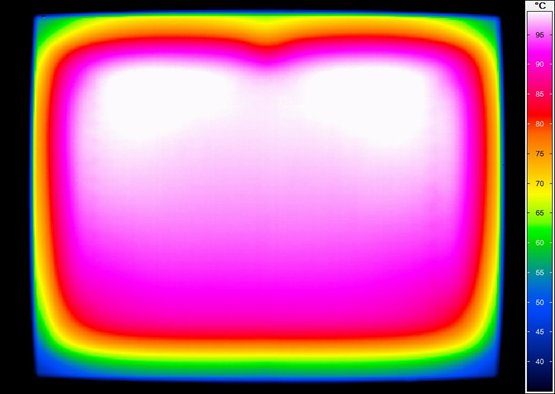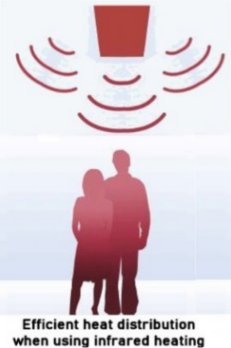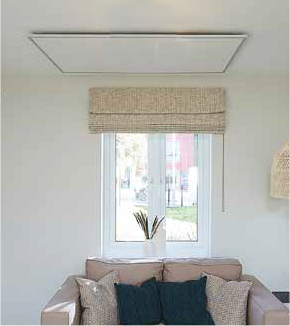Infrared heating
Contents |
[edit] Introduction
As gas and oil heating will be phased out over the next few years, an alternative method of heating may be necessary. Heat pumps, hydrogen and bio mass could be considered alternatives but the inconvenience of installation, use, and cost may preclude them from being a viable replacement for some consumers.
Infrared heating (IR heating) may offer an alternative.
[edit] Optimal room climate
Infrared heaters can use less energy than traditional heating by gas, oil or other forms of electric heating. Traditional heating warms the air providing air circulation but as a result gives away a lot of thermal energy. Additionally, there are energy losses of between 30 and 40 per cent caused by room ventilation.
As infrared heating is direct heat radiation, occupants will perceive the room to be 2 to 3 degrees warmer.
Due to the even temperature distribution in the room, there are almost no air movements caused by the heating and therefore no dust turbulence. Since IR heaters do not dry out the air either, it remains fresh and almost dust-free, which is particularly beneficial for people who are sensitive or have allergies.
[edit] Balanced temperature field
Infrared heaters focus on walls, ceilings, people and furniture and not air. The heat is stored in the thermal mass of those objects and provides heat for a longer period. Consequently, infrared heaters typically need only be working for around 5 hours a day to cover a heating period of 24 hours. During usage the panels will not necessarily be running constantly for the heating period when thermostats are used (see below).
It does of course depend on the individual heat demand which varies from property to property however, in new builds, it should be consistent with the better insulation.
[edit] Extra comfort with radio thermostats
Radio thermostats ensure that heating can be controlled as required. The IR heating system is communicated with by radio link. The thermostat consists of a transmitter and a receiver which is installed between the heater and socket. The thermostat typically provides for up to 6 different temperature changes a day and can be customised for every day of the week. It follows that with its targeted settings energy consumption and costs can be reduced.
[edit] High radiation efficiency and low warm-up phase
Radiation efficiency indicates how much of the heat radiation is emitted by a heat wave heater in the room. The total radiation efficiency of IR panels has been measured by the Technical University of Stuttgart at 71%. After just 4 minutes the IR panels reach a surface temperature of 60 degrees and achieve the required room temperature in a very short time. Despite the rapid warm-up phase IT prevents the risk of burns if the panels are touched.
[edit] No heat loss and cost savings
Infrared heaters generate the required heat directly in the installation room thus preventing heat loss which other heating systems may suffer. IR heaters with their sophisticated technology and special powder coating provide infrared reflecting insulation. This combination ensures better utilisation of thermal energy making them more effective and efficient for reducing heating costs.
An added cost benefit with infrared panels is that a system can be built up over a period by buying one panel at a time, gradually creating a bespoke system for the building.
Infrared heating panels do not require maintenance and can run efficiently for up to forty years.
[edit] Related articles on Designing Buildings
- Combustion plant.
- Cooling.
- Fan coil unit.
- Heating.
- Heat meter.
- Heat metering.
- Heat pump.
- Heat recovery.
- Heat stress.
- Heat transfer.
- Heating large spaces.
- Hot water.
- HVAC.
- Low carbon heating and cooling.
- Overheating.
- Pipework.
- Radiant heating.
- Radiator.
- Tempering heating.
- Thermal comfort.
- Thermostat.
- Types of boiler.
- Types of heating system.
- Underfloor heating.
Featured articles and news
Gregor Harvie argues that AI is state-sanctioned theft of IP.
Many resources for visitors aswell as new features for members.
Using technology to empower communities
The Community data platform; capturing the DNA of a place and fostering participation, for better design.
Heat pump and wind turbine sound calculations for PDRs
MCS publish updated sound calculation standards for permitted development installations.
Homes England creates largest housing-led site in the North
Successful, 34 hectare land acquisition with the residential allocation now completed.
Scottish apprenticeship training proposals
General support although better accountability and transparency is sought.
The history of building regulations
A story of belated action in response to crisis.
Moisture, fire safety and emerging trends in living walls
How wet is your wall?
Current policy explained and newly published consultation by the UK and Welsh Governments.
British architecture 1919–39. Book review.
Conservation of listed prefabs in Moseley.
Energy industry calls for urgent reform.
Heritage staff wellbeing at work survey.
A five minute introduction.
50th Golden anniversary ECA Edmundson apprentice award
Showcasing the very best electrotechnical and engineering services for half a century.
Welsh government consults on HRBs and reg changes
Seeking feedback on a new regulatory regime and a broad range of issues.
CIOB Client Guide (2nd edition) March 2025
Free download covering statutory dutyholder roles under the Building Safety Act and much more.




























Comments
[edit] To make a comment about this article, click 'Add a comment' above. Separate your comments from any existing comments by inserting a horizontal line.